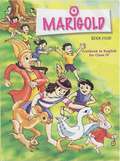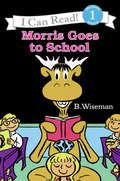- Table View
- List View
Marigold II class 2 - Ncert
by NcertThis book prescribed by central board of secondary education, India for the students of class 2 subject English. This accessible version of the book doesn't leave any part of the book. The book is handy companion of the school going students.
Mastering Public Relations
by Shannon A. Bowen Brad Rawlins Thomas MartinThis book provides an executive review of the field of public relations with a focus on what managers need to know in order to master the function quickly and effectively. Throughout the text, we integrate the academic with the professional by asking, how can an executive use this knowledge to make the most of the public relations function, department, and initiatives in order to help their whole organization be successful? , , , and of the book provide the busy manager with the taxonomy of the public relations field, provide research on the theory of public relations, and examine the structure of organizations and where public relations fits within that structure. , , , and examine how public relations should be conducted in order to achieve maximum results and provide a comprehensive review of public relations strategy, including how to conduct a public relations campaign. , , , and discuss the organizational settings most common in public relations: corporate, agency, government, or public affairs and nonprofit or advocacy groups and the public relations approaches common in each. We review what research finds regarding the most excellent ways to manage public relations and the best ways to analyze and address the ethical challenges to be faced in public relations. We occasionally use short case examples to illustrate and apply the main points managers will need to know in order to manage public relations effectively. Throughout this book, we focus on the managerial pursuits in public relations, such as strategic relationship maintenance, segmentation of publics, and conducting research. We offer insight into the managerial activities of issues management, lobbying and advocacy, creating stakeholder relationships, reputation management, ethical counsel, and corporate communication. We examine the most current thought in public relations to help the busy manager master the most important concepts in the field quickly, accessibly, and with an eye toward helping an organization or client achieve the most effective results through cutting-edge, modern, research-based strategic public relations management.
Mastering Strategic Management
by Dave Ketchen Jeremy ShortTeaching the strategic management course can be a challenge for many professors. In most business schools, strategic management is a "capstone" course that requires students to draw on insights from various functional courses they have completed (such as marketing, finance, and accounting) in order to understand how top executives make the strategic decisions that drive whether organizations succeed or fail. Although students have taken these functional courses, many students have very little experience with major organizational choices. It is this inexperience that can undermine many students' engagement in the course.
Mastering Strategic Management
by Dave Ketchen Jeremy ShortTeaching the strategic management course can be a challenge for many professors. In most business schools, strategic management is a "capstone" course that requires students to draw on insights from various functional courses they have completed (such as marketing, finance, and accounting) in order to understand how top executives make the strategic decisions that drive whether organizations succeed or fail. Although students have taken these functional courses, many students have very little experience with major organizational choices. It is this inexperience that can undermine many students' engagement in the course.
Microeconomics
by Russell Cooper A. Andrew JohnThis textbook, Microeconomics: Theory Through Applications, centers around student needs and expectations through two premises: ... Students are motivated to study economics if they see that it relates to their own lives. ... Students learn best from an inductive approach, in which they are first confronted with a problem, and then led through the process of solving that problem. Many books claim to present economics in a way that is digestible for students; Russell and Andrew have truly created one from scratch. This textbook will assist you in increasing students' economic literacy both by developing their aptitude for economic thinking and by presenting key insights about economics that every educated individual should know.
Money and Banking
by Robert E. WrightThe financial crisis of 2007-8 has already revolutionized institutions, markets, and regulation. Wright's Money and Banking V 2.0 captures those revolutionary changes and packages them in a way that engages undergraduates enrolled in Money and Banking and Financial Institutions and Markets courses.
Money and Banking
by Robert E. WrightThe financial crisis of 2007-8 has already revolutionized institutions, markets, and regulation. Wright's Money and Banking V 2.0 captures those revolutionary changes and packages them in a way that engages undergraduates enrolled in Money and Banking and Financial Institutions and Markets courses.
Money and Banking
by Robert E. WrightThe financial crisis of 2007-8 has already revolutionized institutions, markets, and regulation. Wright's Money and Banking V 2.0 captures those revolutionary changes and packages them in a way that engages undergraduates enrolled in Money and Banking and Financial Institutions and Markets courses.
Money and Banking v 1.1
by Robert E. Wright Vincenzo QuadriniVersion 1.1 includes comprehensive figure updates to reflect most current dates and data, and some significant updates to chapter information like: regulatory reform update (Dodd-Frank Wall Street Reform and Protection Act), and newly added suggested readings (based on current research by authors). The financial crisis of 2007-8 has already revolutionized institutions, markets, and regulation. Wright and Quadrini's Money and Banking V1.1 captures those revolutionary changes and packages them in a way that engages undergraduates enrolled in Money and Banking and Financial Institutions and Markets courses.
Money and Banking v 2.0
by Robert E. WrightThe financial crisis of 2007-8 has already revolutionized institutions, markets, and regulation. Wright's Money and Banking V 2.0 captures those revolutionary changes and packages them in a way that engages undergraduates enrolled in Money and Banking and Financial Institutions and Markets courses. Minimal mathematics, accessible language, and a student-oriented tone ease readers into complex subjects like money, interest rates, banking, asymmetric information, financial crises and regulation, monetary policy, monetary theory, and other standard topics. Numerous short cases, called "Stop and Think" boxes, promote internalization over memorization. Exercise drills ensure basic skills competency where appropriate. Short, snappy sections that begin with a framing question enhance readability and encourage assignment completion. The 2.0 version of this text boasts substantive revisions (additions, deletions, rearrangements) of almost every chapter based on the suggestions of many Money and Banking instructors. Some specific highlights are: Chapter 11 now contains enhanced descriptions of recent regulatory changes, including Dodd-Frank, Chapter 12 is an entirely new chapter on derivatives covering forwards, futures, options, and swaps that also including comprehensive treatment of the causes and consequences of financial crises, and Chapter 14 has updated discussions of the Federal Reserve's monetary policy tools, including paying interest on reserves, and the structure and leadership of the European Central Bank. Recent financial turmoil has increased student interest in the financial system but simultaneously threatens to create false impressions and negative attitudes. This up-to-date text by a dynamic, young author encourages students to critique the financial system without rejecting its many positive attributes. Peruse the book online now to see for yourself if this book fits the needs of your course and students.
Morris Goes to School (I Can Read Level 1)
by B. WisemanMorris the Moose can’t read or count, so he decides to go to school. After a day of ABCs and 123s, Morris is thrilled with all that he has learned.This classic silly Level One I Can Read is perfect for shared reading with a child. For fans of Danny and the Dinosaur, Sammy the Seal, or anyone who loves to read silly stories about animals.
Motion Mountain: The Adventure of Physics (Vol I. Fall, Flow and Heat)
by Christoph SchillerAn open source textbook
Motion Mountain: Relativity, Twenty-third edition)
by Christoph SchillerThis book is written for anybody who is curious about nature and motion. Curiosity about how people, animals, things, images and empty space move leads to many adventures.


